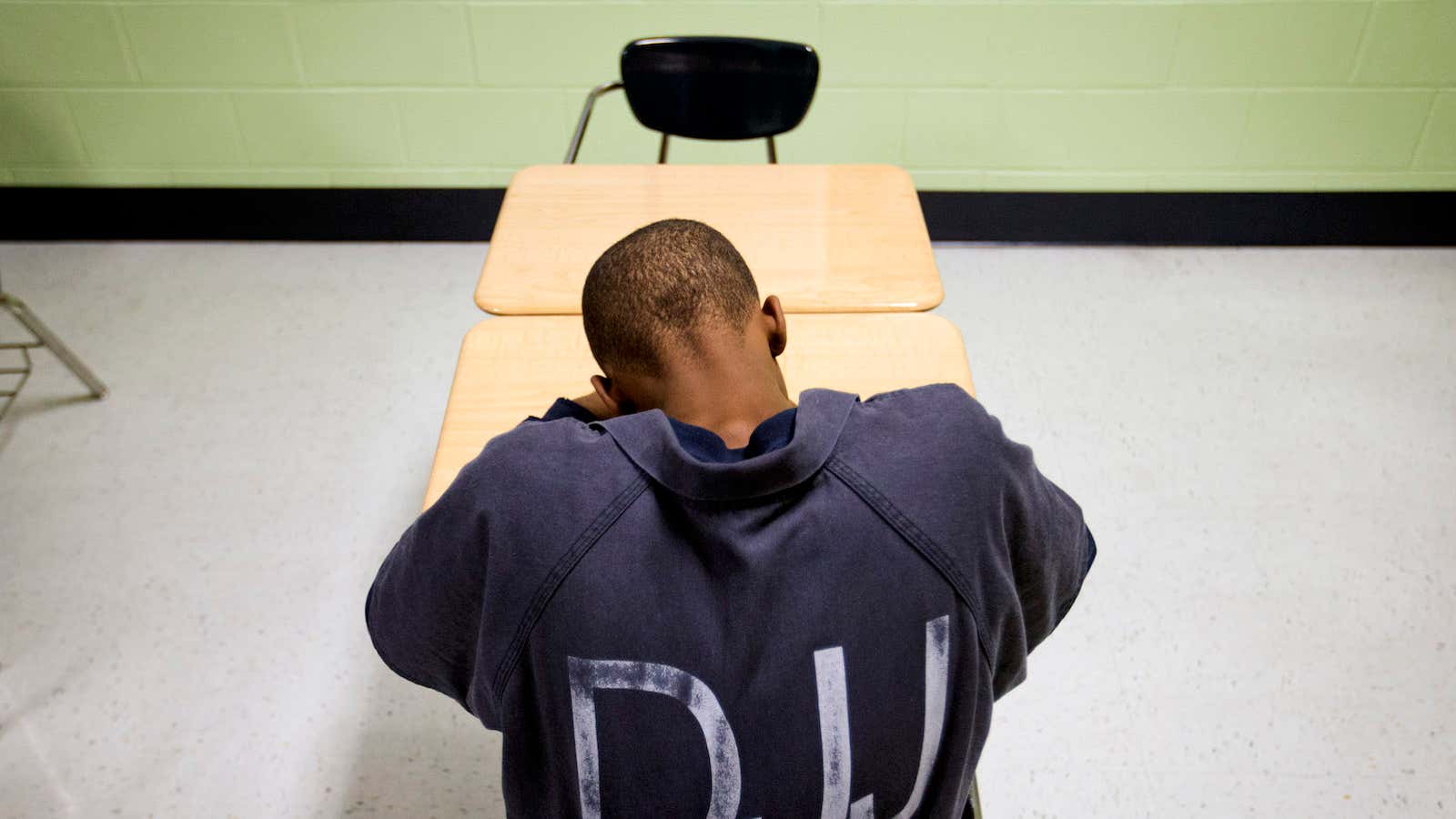The mass incarceration epidemic in the US has been getting much-deserved attention in recent years. What’s less well known is that some of the worst atrocities in the prison system are being committed against children—the US is the largest jailer of children in the world. With the looming presidential election putting prison reform in the spotlight, now is the time to reverse decades of bad policies.
Putting children in prison has a devastating impact on their families and communities, as well as on young people themselves. There are many examples of these atrocities in action. The Lincoln Hills youth facility in Irma, Wisconsin, is one of the largest youth prisons in the US. In the past 18 months, the facility has been the subject of federal and state investigations stemming from allegations of physical and sexual abuse, as well as guards using intimidation tactics to discourage youth from reporting incidents of pepper spray use, strangulation, and suffocation. In one incident, a boy’s toes were amputated after a staff member slammed a heavy door on his foot.
For the past several years, the Connecticut Juvenile Training School, Connecticut’s largest youth prison, has been under multiple investigations by the Office of the Child Advocate for excessive use of isolation, overuse of restraints, inadequate suicide prevention, lack of appropriate staff support and training, inadequate and harmful crisis management, and scant available information on quality, public safety outcomes, and oversight. Last year, the Child Advocate’s office released video of staff members conducting face-down restraints on young people at the training school—which are illegal in Connecticut schools and treatment centers.
In Florida, the Arthur G. Dozier School for Boys had many reported allegations of abuse throughout its 100-plus year existence. Just before its closure in 2011, the US Department of Justice (DOJ) found that more than 100 boys died at the facility from fires, physical trauma, drowning, disease, and injuries following attempted escapes. Youths there were flogged and placed in isolation; one even died after being placed in a sweatbox.
These abuses are not limited to a few “bad apple” facilities. According to reports from incarcerated youth around the US, abuse and violence by prison staff is common. It is unconscionable for both guards and governments to treat children this way. But the lack of urgency in the public’s response to these abuses is equally appalling. As a nation, we need immediate action to end our extreme over-reliance on youth imprisonment. Public outcry is the only way to stop these abuses.
In order to achieve better outcomes, we first need to listen to what research and experience shows us about better ways to rehabilitate. Research proves that incarceration actually increases crime: Young people sent to youth prisons instead of community treatment programs are much more likely to commit more crimes upon release. Across the country, youths, families, and advocates are campaigning for reforms in places like Virginia, Kansas, Connecticut, Wisconsin, and Washington State. These campaigns are pushing for states to close youth prisons and reinvest in effective community-based alternatives to youth incarceration.
Next, we need to end the financial incentives that have created a pipeline to prison, particularly in communities of color. Targeted law enforcement in neighborhoods and schools with predominantly young people of color have contributed to glaring racial disparities across the juvenile justice system. The 1994 Violent Crime Control and Law Enforcement Act (often referred to as the Crime Bill) included a provision called the Violent Offender Incarceration Program. This provided billions in federal-grant funds for states to build or renovate prisons. The funding for new prison construction encouraged states to expand its reliance on incarceration rather than expand more effective community alternatives. The Bureau of Justice Statistics reports that more than half the states built, expanded, and renovated youth prisons and juvenile detention facilities, as well as contracted for additional detention and correctional beds. California spent $250 million of these funds to build nearly 3,500 youth prison beds in 38 counties.
Instead of providing more money for prisons, the DOJ should invest resources and assist localities to dismantle the youth prison model and expand alternatives to incarceration. Programs in Ohio, Michigan, and New York City show some ways that it can be done. For example, in 1994, Ohio passed legislation that shifted funding from state-run youth prisons to local counties to encourage investment in community-based treatment options. Local officials in Wayne County, Michigan, and New York City convinced state leaders to grant their jurisdictions the resources and authority to create locally operated juvenile-justice programs in lieu of sending young people to state-operated youth prisons. Now, young people in Detroit and the Bronx receive community-based mentoring and case management instead of being sent to far-away youth prisons in rural communities.
Additionally, Congress should reauthorize and adequately fund the Juvenile Justice and Delinquency Prevention Act of 1974. This would ensure that states continue to protect system-involved youth and are able leverage federal resources to invest in reforms that keep young people out of youth prisons and in their homes and communities.
We are also desperately in need of a new national commission to provide leadership and take a fresh look at how we can come together to decrease our reliance on imprisoning young people. And maybe that moment is finally now.
The dynamics of the 2016 presidential campaign highlight changing attitudes regarding our nation’s punitive crime policies. Hillary Clinton has repudiated her support of the 1994 Crime Bill and has made ending mass incarceration a priority issue. Likewise, a number of Republicans and Democrats alike have rejected Donald Trump’s throwback calls for “law and order.” Instead, there is a bipartisan consensus behind the need for wholesale reform of the American criminal justice system—juvenile justice reform included. As the US seeks to roll back harmful criminal-justice policies, we need to make sure that children are a part of the conversation.
